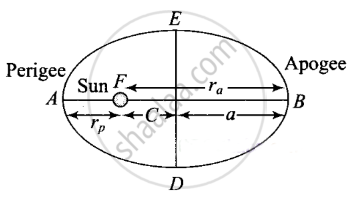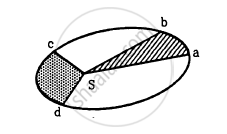Advertisements
Advertisements
प्रश्न
A satellite is in an elliptic orbit around the earth with aphelion of 6R and perihelion of 2 R where R= 6400 km is the radius of the earth. Find eccentricity of the orbit. Find the velocity of the satellite at apogee and perigee. What should be done if this satellite has to be transferred to a circular orbit of radius 6R ?
[G = 6.67 × 10–11 SI units and M = 6 × 1024 kg]
उत्तर
According to the diagram,
rp = radius of perigee = 2R
ra = radius of perigee = 6R
a = semi-major axis of the ellipse
Hence, we can write
`r_a = a(1 + e) = 6R`
`r_p = a(1 - e) = 2R`
`(a(1 + e))/(a(1 - e)) = (6R)/(2R)` = 3

By solving, we get eccentricity `e = 1/2`
If va and vp are the velocities of the satellite (of mass m) at aphelion and perihelion respectively, then by conservation of angular momentum
`L_("at perigee") = L_("at apogee")`
∴ `mv_pr_p = mv_ar_a`
∴ `v_a/v_p = r_p/r_a = 1/3`
Applying conservation of energy,
The energy at perigee = Energy at apogee
`1/2 mv_p^2 - (GMm)/r_p = 1/2 mv_a^2 - (GMm)/r_a`
Where M is the mass of the earth
∴ `v_p^2 (1 - 1/9) = - 2GM (1/r_a - 1/r_p)`
= `2GM(1/r_p - 1/r_a)` .....(By putting `v_a = v_p/3`)
`v_p = [2GM(1/r_p - 1/r_a)]^(1/2)/([1 - (v_a/v_p)^2]^(1/2)`
= `[((2GM)/R (1/2 - 1/6))/((1 - 1/9))]^(1/2)`
= `((2/3)/(8/9) (GM)/R)^(1/2)`
= `sqrt(3/4 (GM)/R)`
= 6.85 km/s
vp = 6.885 km/s, va = 2.28 km/s
For circular orbit of radius r,
vc = orbital velocity = `sqrt((GM)/r)`
For r = 6R, vc = `sqrt((GM)/(6R)` = 3.23 km/s.
APPEARS IN
संबंधित प्रश्न
Let us assume that our galaxy consists of 2.5 × 1011 stars each of one solar mass. How long will a star at a distance of 50,000 ly from the galactic centre take to complete one revolution? Take the diameter of the Milky Way to be 105 ly
A Saturn year is 29.5 times the earth year. How far is the Saturn from the sun if the earth is 1.50 ×108 km away from the sun?
In the Following figure shows the elliptical path of a planet about the sun. The two shaded parts have equal area. If t1 and t2 be the time taken by the planet to go from a to b and from c to d respectively,

Answer the following question.
State Kepler’s law of equal areas.
Observe the given figure and answer these following questions.

The orbit of a planet moving around the Sun
- What is the conclusion about the orbit of a planet?
- What is the relation between velocity of planet and distance from sun?
- Explain the relation between areas ASB, CSD and ESF.
Write the Kepler's laws.
To verify Kepler's third law graphically four students plotted graphs. Student A plotted a graph of T (period of revolution of planets) versus r (average distance of planets from the sun) and found the plot is straight line with slope 1.85. Student B plotted a graph of T2 v/s r3 and found the plot is straight line with slope 1.39 and negative Y-intercept. Student C plotted graph of log T v/s log r and found the plot is straight line with slope 1.5. Student D plotted graph of log T v/s log r and found the plot is straight line with slope 0.67 and with negative X-intercept. The correct graph is of student
If the sun and the planets carried huge amounts of opposite charges ______.
- all three of Kepler’s laws would still be valid.
- only the third law will be valid.
- the second law will not change.
- the first law will still be valid.
A planet revolving in an elliptical orbit has:
- a constant velocity of revolution.
- has the least velocity when it is nearest to the sun.
- its areal velocity is directly proportional to its velocity.
- areal velocity is inversely proportional to its velocity.
- to follow a trajectory such that the areal velocity is constant.
Choose the correct answer from the options given below:
Halley's Comet revolves around the sun for a time period of 76 years. The aphelion distance if perihelion is given by 8.9 × 1010 m, will be ______.
(Take, the mass of sun = 2 × 1030 kg and G = 6.67 × 10-11 Nm3/kg2)
